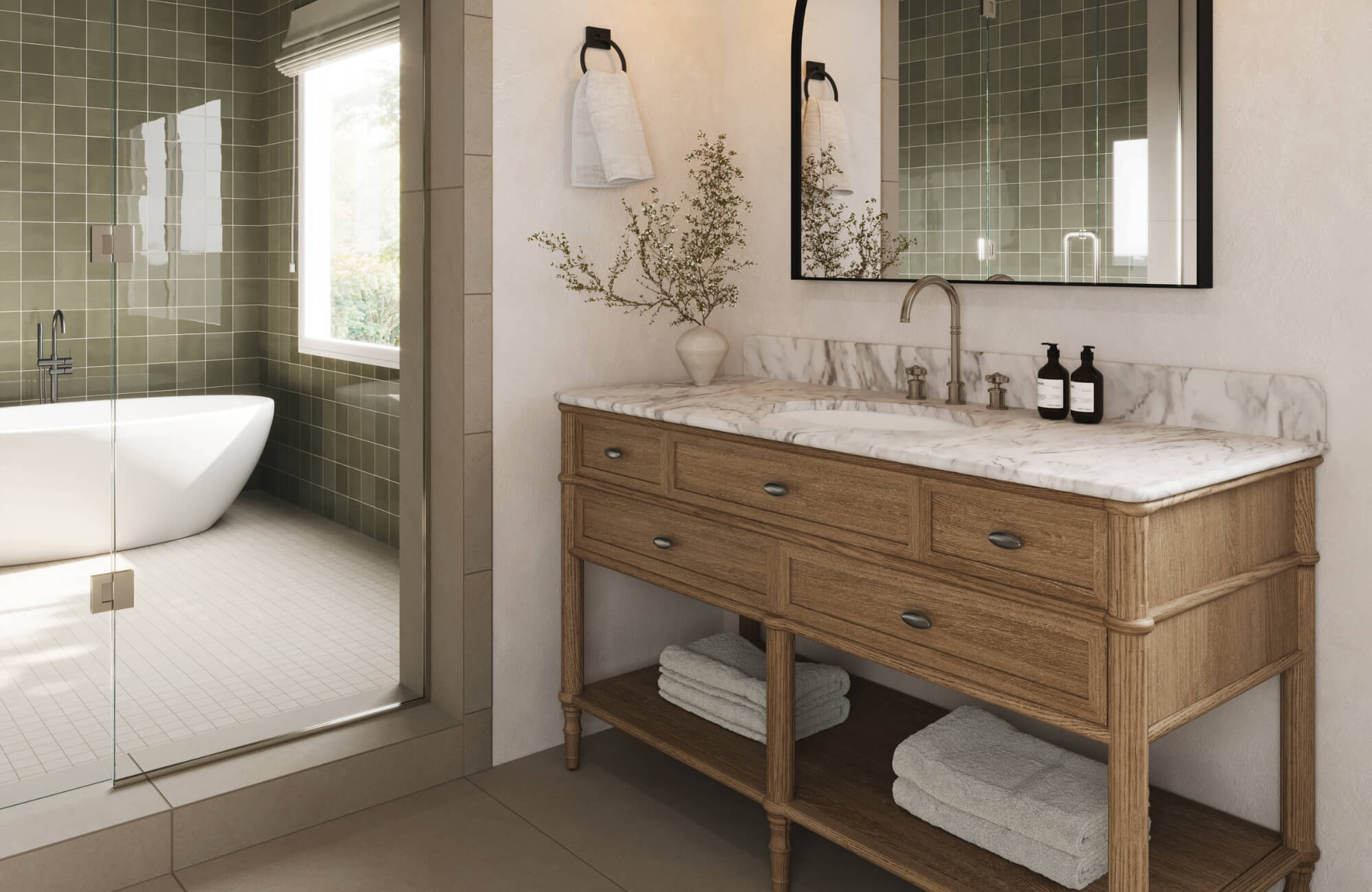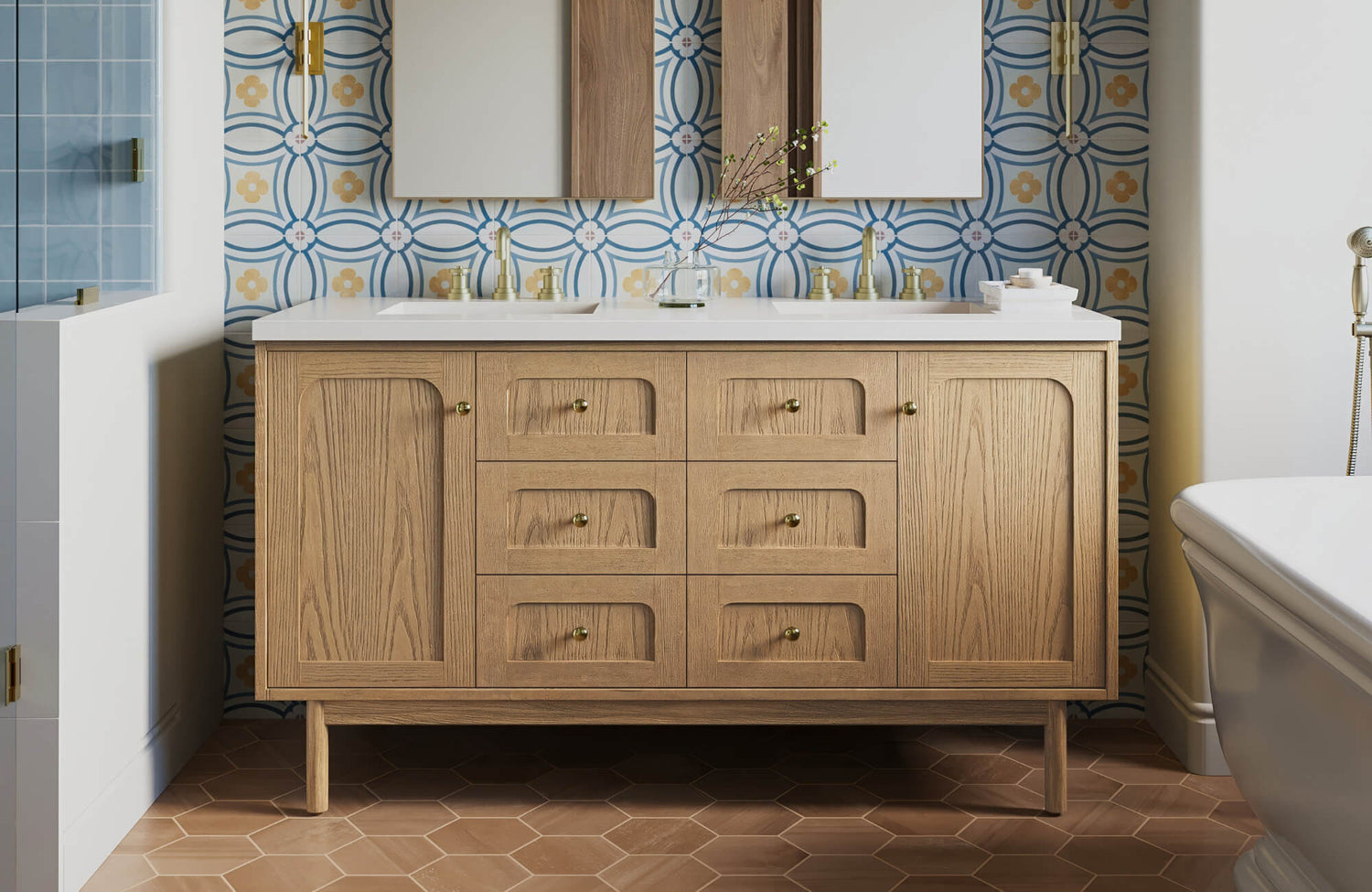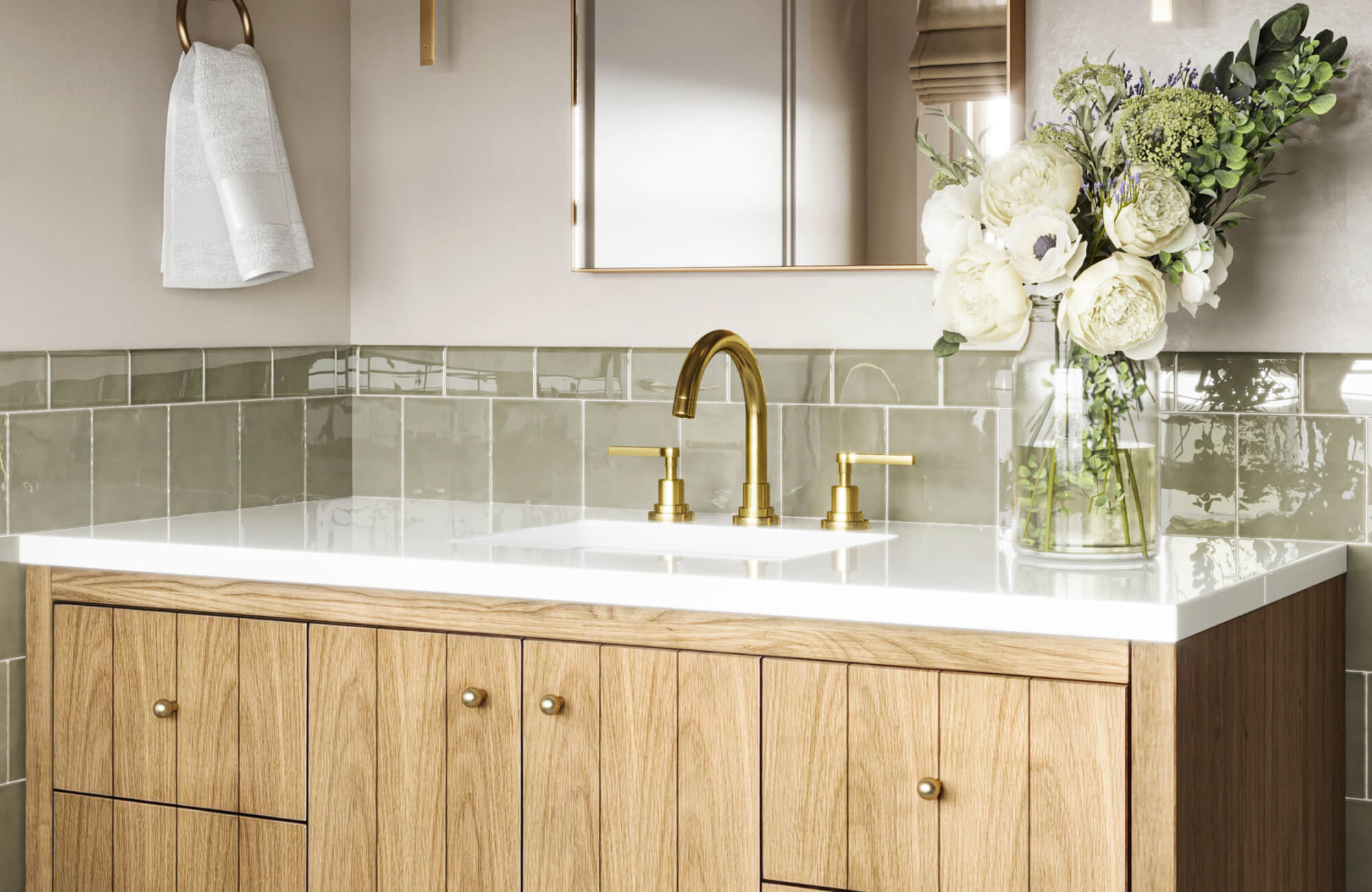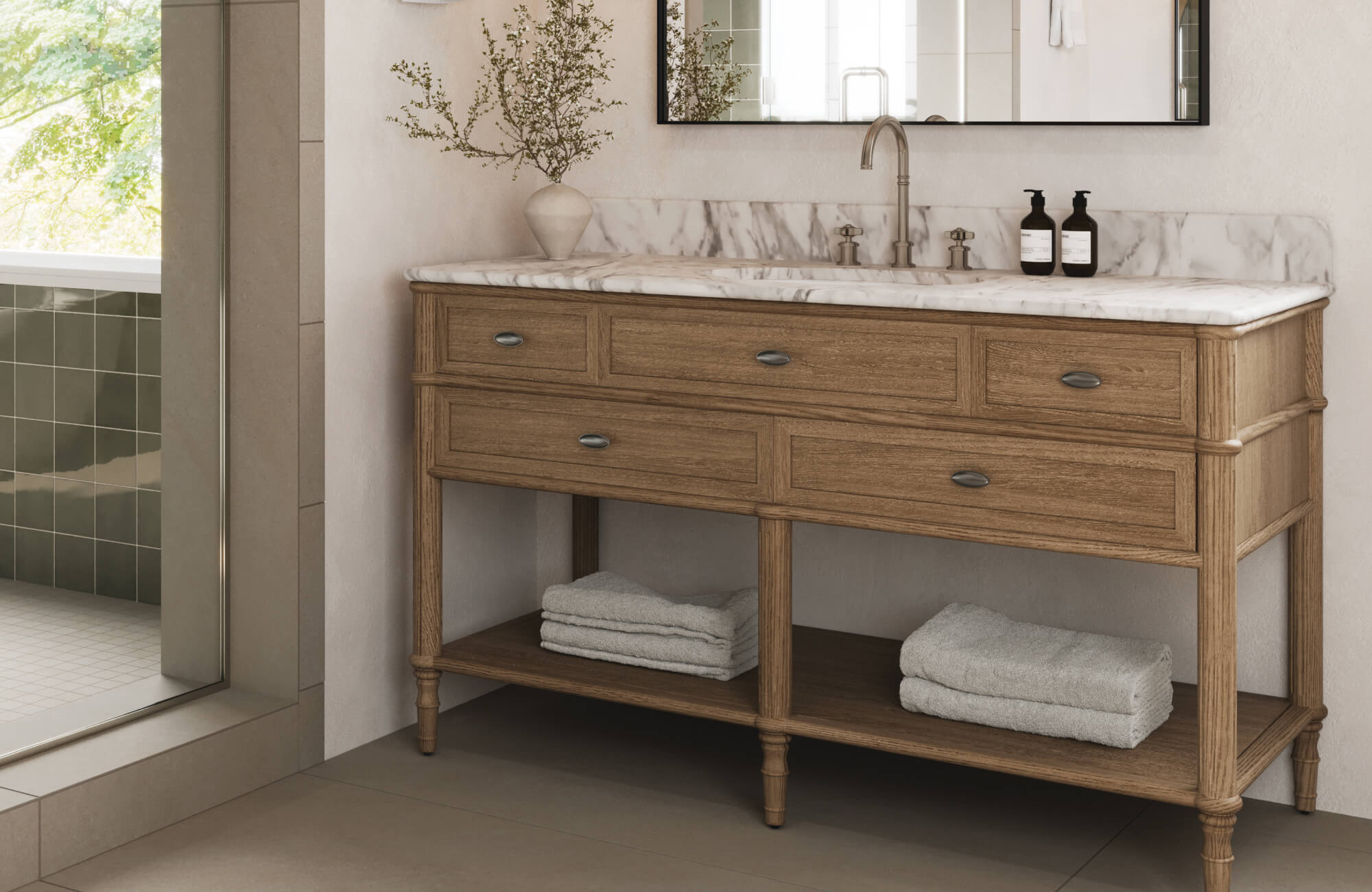A modern vanity is more than a fixture, it serves as the functional and visual anchor of a bathroom or dressing area. Not only does it conceal plumbing and support daily routines, but it also helps define the room’s overall design through carefully selected materials, thoughtful scale, and cohesive finishes.
As needs shift and styles evolve, vanities have become increasingly versatile, incorporating space-smart layouts, integrated lighting, and customizable storage solutions. Throughout this blog, we’ll explore how today’s vanities merge practical performance with design appeal, and highlight what to consider when selecting the one that best fits your space.
The Functional Core of a Bathroom Vanity
While vanities often get attention for their style, their true value lies in how they support everyday use. From managing plumbing behind the scenes to organizing grooming routines up front, they are essential to the bathroom’s overall functionality and day-to-day efficiency.
Integrating Plumbing and Water Access
At the foundation of this functionality, a core purpose of the vanity is to house and provide access to standard plumbing components such as sink basins, supply lines, and drain assemblies. Designed with removable panels or open backs, most vanities ensure that maintenance is easy and noninvasive. They must also accommodate essential elements like P-traps and shut-off valves without compromising structural integrity.
To enhance durability, vanities are typically constructed from moisture-resistant materials such as MDF with water-repellent coatings, marine-grade plywood, or thermally fused laminates. In many modern designs, pre-drilled configurations and modular interiors simplify installation, particularly in retrofit scenarios. As sustainability becomes a greater priority, many vanities are now designed to pair with low-flow or sensor-activated faucets, incorporating discreet compartments to house control modules or batteries.
Centralizing Personal Grooming Activities
In addition to plumbing integration, vanities also function as daily-use grooming stations, supporting routines like shaving, skincare, and hairstyling. Most include ergonomically positioned countertops, typically 32 to 36 inches high, designed for comfort and accessibility. Integrated lighting, whether built into mirrors or mounted as part of the vanity, enhances visibility for detail-oriented tasks.
Equally important, storage features contribute to workflow and order. Soft-close drawers, tiered compartments, and specialized organizers keep personal items accessible without visual clutter. Some premium designs go a step further, integrating thoughtful conveniences that support modern grooming routines. Additional elements like anti-fog mirrors and recessed medicine cabinets further elevate functionality. Together, these details transform the vanity into a well-organized, design-forward centerpiece that balances efficiency with aesthetic clarity.

Maximizing Storage and Organization
Smart storage is what truly sets a great vanity apart, turning everyday clutter into an organized, accessible system. By combining spacious cabinetry with purpose-built drawers, vanities help ease both long-term storage and daily routines.
Cabinetry for Bulk Storage
To start with larger storage needs, base cabinets are designed to house bulkier, less frequently used items, such as towels, paper goods, and cleaning supplies, while accommodating plumbing and structural constraints. Many models incorporate adjustable or removable shelves for flexibility, along with soft-close doors to increase durability and reduce noise.
For added functionality, some designs include pull-out bins for discreet access to larger items or tower cabinets that expand vertical storage without taking up additional floor space. Materials such as marine-grade plywood and high-density engineered wood enhance structural integrity in moisture-rich environments.
A prime example is Edward Martin’s Josephine 60" Double Vanity in Satin Drifted Black Veneer with Carrara Marble Top, as shown in the image above. With its central drawer column and flanking cabinet doors, this vanity offers a well-balanced mix of concealed bulk storage and refined design, making it a standout choice for style-driven, high-function bathrooms.
Drawers for Everyday Essentials
While cabinets handle bulk storage, drawers focus on accessibility, keeping items like skincare, grooming tools, and personal products neatly organized and within reach. Features such as full-extension slides, dovetail joinery, and undermount glides ensure smooth, long-lasting performance.
In addition, many modern vanities now include modular inserts for item-specific organization, along with multi-tiered drawer systems to separate contents by function or user. Some high-end models even integrate power outlets or USB ports, allowing electric tools to be charged and stored in one convenient location.
Finally, innovations like U-shaped or cut-out drawers maximize space around plumbing fixtures, putting every inch to good use. Taken together, these storage solutions transform the vanity into an efficient, design-forward hub that supports both daily routines and clean aesthetics.

Enhancing Bathroom Aesthetics and Design
While a vanity anchors the bathroom functionally, it also carries the power to shape the room’s entire aesthetic and elevate its perceived quality. Whether you're designing from scratch or upgrading an existing space, the right vanity can tie everything together and boost long-term value.
Defining the Bathroom's Style
To begin with, a vanity’s form, finish, and material palette set the tone for the entire bathroom. Whether you lean toward minimalist, transitional, or rustic aesthetics, the vanity often acts as the stylistic centerpiece. For instance, a floating unit with slab-front drawers and a matte finish emphasizes clean lines in contemporary spaces, while a furniture-style piece with turned legs and distressed wood evokes traditional charm.
Beyond structure and silhouette, countertop materials like quartz and marble add depth and luxury, especially when paired with integrated or under-mount sinks. Likewise, hardware finishes such as brushed brass or matte black help tie the vanity to mirrors, lighting, and plumbing fixtures. Design accents like fluted panels, and beveled edges add further sophistication. Together, these elements allow the vanity to serve not just as a functional component but as a bridge that harmonizes all surrounding materials.
Impact on Overall Room Value
In addition to visual impact, a well-chosen vanity can significantly enhance the value and marketability of a bathroom. High-quality construction, durable materials, and thoughtful storage features signal a well-planned space, traits that resonate with both owners and potential buyers. In real estate, vanities with custom or semi-custom details often contribute to higher resale value and greater buyer appeal.
Moreover, using premium materials, such as solid wood cabinetry, natural stone countertops, and moisture-resistant finishes, adds both longevity and a sense of craftsmanship. Vanities that incorporate universal design principles, such as ADA-compliant heights or accessible layouts, also broaden usability across age groups and needs.
A perfect illustration of this balance is Edward Martin’s Gemma 55" Single Vanity in Washed Blonde Oak Veneer with Carrara Marble Top, featured above. Its turned legs, open shelving, and refined proportions not only elevate the overall design but also reinforce a sense of lasting quality, making it a strong asset in both style-focused upgrades and value-driven renovations.

Tailoring a Vanity to Your Needs
Finding the right vanity isn’t just about looks, it’s about making sure it fits your space, suits your routine, and works smarter for your needs. From getting the dimensions right to adding thoughtful extras, the details make all the difference.
Sizing for Space and Utility
To begin, getting the vanity dimensions right is key to ensuring both comfort and usability, making careful spatial planning essential. A minimum of 21 inches of front clearance allows for ease of movement, while standard heights between 30 to 36 inches accommodate most users ergonomically. In more compact bathrooms, single-sink vanities ranging from 18 to 36 inches wide offer practical functionality without overwhelming the layout. In these settings, floating vanities are particularly useful, as they create a sense of openness and simplify floor maintenance.
Conversely, larger bathrooms often benefit from double-sink vanities, typically between 60 and 72 inches wide, which provide ample counter space and individualized storage. Depth also becomes an important factor: while standard models are around 21 inches deep, slim-profile options as narrow as 18 inches suit tighter configurations. To maintain design harmony, it’s important to align the vanity with plumbing rough-ins, foot flow, and door clearance.
As pictured above, Edward Martin’s Colton 36" Single Vanity in Sable with a 3 cm White Zeus Quartz Top proves that small-scale vanities can deliver big on both style and function. Its clean lines and compact footprint provide integrated storage without sacrificing elegance, making it a smart choice for space-conscious design.
Incorporating Specialized Features
Beyond basic dimensions, today’s vanities offer a range of specialized features that enhance convenience, customization, and user experience. As mentioned earlier, integrated power outlets and USB ports support tech-driven grooming routines, while additions like soft-open hinges or touchless drawers improve accessibility and hygiene, particularly in shared or multi-generational homes. For premium functionality, some models even include refrigerated drawers for storing skincare products or medications.
Lighting is another key upgrade. Motion-activated toe-kick lighting or mirror-integrated LEDs, calibrated to daylight color temperatures (around 5000K), offer enhanced visibility while also contributing to the room’s ambient atmosphere. To ensure longevity, many vanities are equipped with antimicrobial surfaces, waterproof drawer linings, and moisture-resistant laminates, ideal for humid environments. Organizational options such as modular dividers and tiered trays further tailor the experience to individual storage needs.
Even plumbing components can be personalized. Vessel sinks create extra under-counter storage and visual impact, while under-mount sinks offer an easy-to-clean surface. Wall-mounted faucets, meanwhile, free up countertop space and enhance ergonomics. Altogether, these innovations transform the vanity from a static furnishing into a dynamic, fully integrated centerpiece tailored to modern living.

The Synergy of Vanity and Tile in Bathroom Design
The relationship between a vanity and the surrounding tile is key to creating a bathroom that feels both polished and practical. When thoughtfully paired, these elements work together to enhance visual flow, durability, and the overall design narrative.
Complementary Tile Backsplashes
To start, a tile backsplash not only protects the wall from moisture but also strengthens the vanity’s presence within the space. Whether installed between the countertop and mirror or extended to the ceiling, it acts as a visual bridge that ties together surrounding materials, which is particularly effective in contemporary designs. Common backsplash materials such as ceramic, porcelain, glass, and natural stone each offer distinct advantages in terms of maintenance, performance, and texture.
Depending on your design goals, backsplashes can either echo or contrast the vanity’s finish to create cohesion or add interest. For instance, a white oak vanity pairs naturally with muted zellige tiles for a tonal, tactile effect, while matte black or navy hexagonal porcelain introduces bold contrast to sleek, minimalist designs. Grout selection also influences the final look; color-matched grout creates a clean, understated finish, while contrasting grout introduces visual texture and definition, subtly shaping the overall aesthetic.
Take, for instance, the pairing featured above: Edward Martin’s Gwen 48" Single Vanity in Pebble Oak with a 3 cm White Zeus Quartz Top is matched with the Sarina 3x12 Glossy Ceramic Fishscale Tile in Cloud. The result is a refined interplay of textures and tones, the vanity’s natural wood grain grounded by the soft, reflective curves of the tile, creating a focal point that’s as functional as it is visually striking.
Floor and Wall Tile Considerations
Beyond backsplashes, floor and wall tiles influence the bathroom’s functionality and spatial perception. Slip-resistant porcelain with matte or textured finishes remains a top choice for wet areas and should meet ANSI A137.1 safety standards. Depending on the color and size, a darker floor tile can ground a lighter vanity, while large-format neutral tiles can visually expand smaller bathrooms.
In terms of layout, rectified edge tiles installed in a linear pattern offer a crisp, contemporary look, while mosaic inlays or tile “rugs” can softly delineate areas such as the grooming zone. Extending wall tile from floor to ceiling, particularly in moisture-prone environments, adds vertical continuity and protects against humidity. In these applications, using waterproof membranes like Schluter or RedGard is essential for long-term performance.
To simplify your selection process, Edward Martin’s design consultation service provides one-on-one guidance from concept to completion. From curated tile samples to layout and finish advice, this expert support ensures your vanity and tile selections complement one another in both tone and proportion. For added help with coordinating materials such as rugs, lighting, or fixtures, don’t hesitate to contact Edward Martin for personalized recommendations tailored to your vision.
The Essential Role of the Vanity
In the end, a well-chosen vanity does more than fill space; it supports daily routines, conceals plumbing, and anchors the room’s overall aesthetic. With the right size, features, and materials, it becomes a great blend of form and function.
As you begin planning your next bathroom update, let the vanity guide the design direction. For inspiration that balances style with everyday performance, turn to the expert insight and curated selections available at Edward Martin.








